Alexander Huber: “Ogre is not a man-eater”
Ogre has on the Huber brothers almost the same effect as the singing of the Sirens in Greek mythology: the two German top climbers can hardly escape the call of this fascinating granite giant. Time and again in their long careers Alexander and Thomas Huber have set off to the Ogre massif in the Karakoram or the nearby peaks of the Latok group. In 1999, they failed in their attempt to climb the 7,285-meter-high Ogre I. Thomas succeeded the second ascent of the mountain in 2001, along with the two Swiss Urs Stoecker and Iwan Wolf. The first ascent was made almost 40 years ago, on 13 July 1977 by the British climbers Chris Bonington and Doug Scott. The descent became a drama with a happy end: Scott broke both ankles, Bonington two ribs. Nevertheless, both of them, supported by the other team members, reached the base camp one week after their summit success – one of the great survival stories on the highest mountains in the world.
Easier doing it with friends
Yesterday Alexander Huber set off to Ogre. His team includes the two East Tyroleans Mario Walder and Christian Zenz and the Swiss Dani Arnold. With Dani (and Thomas Senf), Alexander had opened a new route through the Matterhorn North Face last March. With Mario and Christian, he had succeeded the first ascent of a route on the mountain Ritterknecht in East Greenland in summer 2016. “It’s good to be on the road with partners you know,” says Alexander Huber. His three companions are not only good, competent climbers, but also friends, says the younger of the two Huber brothers. “You have to spend a lot of time together, often moments of tension. The better the human chemistry fits, the better it is.” I talked with the 48-year-old about his expedition before he left for Pakistan.
Alexander, you are heading to Ogre, a seven-thousander in the Karakoram. What exactly are you planning?
![]() read more
read more
Kammerlander: “I want to finish my path on Manaslu”
He wants to draw a final line. Late next fall, the South Tyrolean Hans Kammerlander wants to climb the 8163-meter-high Manaslu in Nepal, leaving his trauma of 1991 behind. During a summit attempt, his two friends Friedl Mutschlechner and Karl Großrubatscher had died in a thunderstorm. At that time Kammerlander declared that he would never return to Manaslu. In the years before, Hans, at the side of Reinhold Messner, had written alpine history. Thus the two succeeded the first eight-thousander double traverse on Gasherbrum I and II in Pakistan in 1984 – in Alpine style.
“No alpinism”
Kammerlander has so far climbed twelve of the 14 eight-thousanders. In 1996, he skied down from the summit of Mount Everest via the Tibetan north side. Hans, however, had to take off his skies several times because it was a season with little snow. Meanwhile the 60-year-old has lost any interest in what happens on Everest. “I’m not following this. For me normal Everest ascents have nothing to do with alpinism. Supplemental oxygen, prepared mountains and the Sherpas make everything clear,” the 60-year-old told me. “But everyone should do it as he thinks it’s right. But he should leave no garbage there. He has to leave the mountain clean, then it’s okay for me.” I spoke to Kammerlander about his upcoming Manaslu project, which he wants to realize along with the North Tyrolean mountain guide Stephan Keck.
Hans, Manaslu means “mountain of the spirit”. Does Manaslu still weigh heavily on you?
![]() read more
read more
Mingma Gyalje Sherpa: “Low price, low safety”
“Nepalese climbers have been the shadow for foreign climbers”, says Mingma Gyalje Sherpa. “It is obvious that foreign climbers pay a lot to them for this work and I do respect it but still I feel that Nepalese climbers are not given the credit they rightfully own.” The 31-year-old is the head of the expedition operator “Dreamers Destination” and belongs to a new generation of Sherpa entrepreneurs: young, well trained, reliable and successful. Mingma is also an excellent climber. He has so far scaled eight eight-thousanders, in fall 2015 he made headlines by first climbing a difficult route via the West Face of the 6,685-meter-high Chobutse solo. One of his dreams is to climb Everest without bottled oxygen after five ascents with breathing mask. These days, he is leading a commercial expedition on Dhaugaliri. For a portrait of Mingma that was just published by the German magazine “Allmountain”, I did an interview with him of which I don’t want to deprive you.
Mingma, in the past years some western operators withdraw from Everest complaining about a price war with local operators in Nepal. Is this battle going on?
![]() read more
read more
Steck: “I will distance myself on Everest”
The experience on Mount Everest in spring 2013 has changed Ueli Steck. “The moment when I realized that the Sherpas wanted to kill me, a world came crashing in,” the 40-year-old Swiss top climber wrote in his new book “The Next Step”. “After that, my look at the world was a different one. I withdrew because I did not trust anyone anymore.” In spring 2017, Ueli will return to Everest – to try to traverse the highest mountain on earth and the 8,516-meter-high Lhotse. I talked to Steck about Everest.
Ueli, what does Mount Everest mean for you personally?
Everest is the highest mountain in the world. If high altitude climbing is your thing, it is, with an altitude of 8,848 meters, a dimension of its own and therefore the most interesting and exciting mountain.
![]() read more
read more
Heidi Sand: “You have only one life. Use it!”
Impossibly Heidi Sand could have foreseen that Denali would change her life in this way. When the German mountaineer and sculptor descended from the summit of the highest mountain of North America (6,190 m) in 2010, the then 43-year-old suddenly had strong stomach pain. Soon after the shattering diagnosis: advanced colorectal cancer. After the emergency surgery, chemotherapy followed. “If I survive, I want to reward myself with an eight-thousander,” Heidi then promised herself – and fulfilled this dream of her life: On 26 May 2012 the mother of three children stood on the summit of Mount Everest.
Meanwhile Heidi Sand has passed the critical five-year mark after her cancer diagnosis. She is considered to be cured – and has realized further climbing projects after having summited Everest. In autumn 2013, for example, Heidi scaled Cho Oyu without using bottled oxygen and in spring 2014 she stood on top of Makalu (with breathing mask). With Billi Bierling, Heidi shares the honor of having been the first German women to reach the summit of Makalu. Sand dedicated her three successes on eight-thousanders to her children, for her husband remained the Eiger North Face which she succeeded to climb a year ago, in December 2015. And last November, she tackled, along with the Swiss mountain guide Lorenz Frutiger, the legendary granite giant Fitz Roy in Patagonia – in vain, the weather put a spoke in their wheel. I asked the 50-year-old four questions about her climbing.
Heidi, what do you owe to the mountains, especially Mount Everest?
![]() read more
read more
Oswald Oelz: “Mountaineers are unteachable”
“I will climb until I am dead,” says Oswald Oelz, sitting opposite me recently at the International Mountain Summit in Bressanone. The 73-year-old native of Austria lives as a retiree in an old farmhouse in the Zurich Oberland region in Switzerland. “I have a farm with sheep, parrots, ducks, geese, chickens. I write, read a lot, climb. And I travel around the world.” Oswald called “Bulle” Oelz scaled Mount Everest in 1978, on the same expedition, during which Reinhold Messner and Peter Habeler climbed the highest mountain on earth for the first time without bottled oxygen. Oelz succeeded first ascents in the Alps, in Alaska, Jordan and Oman. Until 2006 he worked as chief physician at the “Triemli hospital” in Zurich. The professor also researched in the field of high altitude medicine.
Oswald Oelz, you are a mountaineer and a doctor, you have got to know both worlds. Time and again, there are fatalities in the high mountains due to high altitude cerebral or pulmonary edema. Has the climbing community learned nothing over the past decades?
![]() read more
read more
Ines Papert: “I’m certainly quite proud”
If a good mood could be converted into electricity, Ines Papert right now wouldn’t need any socket at home. I can literally hear the beaming face of the 42-year-old German top climber on the phone when we talk about her success at the 5842-meter-high Kyzyl Asker in the border area between Kyrgyzstan and China. Along with her 28-year-old Slovenian rope partner Luka Lindic, she has opened – as reported – a spectacular route through the Southeast Face of the mountain. A line where many top climbers had previously failed, she herself twice.
Ines, how does it feel to have fulfilled a dream in the third run (after 2010 and 2011)?
![]() read more
read more
Auer: “No large safety buffer”
“The ability is the measure of what you are allowed to do,” the free climbing pioneer Paul Preuss (1886-1913) wrote – freely translated – more than a hundred years ago. Hansjoerg Auer is able to do a lot and is therefore a well-deserved winner of the “Paul Preuss Award”, which is annually given to an extraordinary climber in the tradition of the legendary Austrian. “Auer belongs undoubtedly to the best climbers in the world,” said Reinhold Messner during the award ceremony at the International Mountain Summit (IMS) in Bressanone last weekend. Meanwhile, Hansjoerg Auer has set off from his native Oetztal for a new adventure. In the far east of Nepal, the Austrian, along with his countryman Alex Bluemel, wants to first climb the North Face of the almost 7,000-meter-high Gimigela Chuli East. The mountain is hidden behind the eight-thousander Kangchenjunga, the third-highest mountain on earth.
Hansjoerg, do you take failure into account?
![]() read more
read more
UIAA chief Frits Vrijlandt: Five questions, five answers
The Netherlands are called so for good reason. The highest “summit”, the Vaalserberg near the town of Aachen, is only 323 meters high. Nevertheless you find “Oranje boven” also on the highest mountains on earth. Frits Vrijlandt is not a blank slate in the climbing scene. In 2000, he was the first Dutchman to climb Mount Everest from the Tibetan north side, later he became the second mountaineer from the Netherlands who scaled the Seven Summits, the highest mountains of all continents. At the International Mountain Summit (IMS) in Bressanone in South Tyrol, the General Assembly of the International Climbing and Mountaineering Federation (UIAA) was held – and Vrijlandt was reelected as President for another four years.
Frits, a man from such a flat country is the head of all climbers worldwide. That sounds a bit strange.
![]() read more
read more
Thomas Huber: “I’ll travel with a laughing heart”
Incredible – that describes Thomas Huber’s current life quite aptly. No wonder that the 49-year-old German top climber uses this word very often when we talk on the phone. Thomas was, as he himself says, “incredibly lucky” when he survived his 16-meter-fall from a rock face on 5 July. He recovered so “incredibly fast” that he – as initially planned before his fall – will shortly go “with incredible joy” on expedition to Pakistan. Truly incredible! The aim of the travel is the north side of the 7,145-meter-high granite giant Latok I in the Karakoram. Huber’s team includes Toni Gutsch – who, in 1997, first climbed the West Face of Latok II (7108 m) along with the Huber brothers and US climber Conrad Anker – and Sebastian Brutscher.
![]() read more
read more
Thomas Huber: “Thanks for staying alive!”
Approximately 1.8 seconds. That was the time it took when Thomas Huber fell 16 meters deep from a rock face on the Brendlberg in the Berchtesgaden region in Bavaria – now two weeks ago. As previously reported, the 49-year-old German top climber, the older of the two Huber brothers, landed on soft forest floor. As it turned out later, Thomas suffered a skull fracture and had to undergo surgery immediately. The doctor’s reassuring prognosis afterwards: no permanent damage. Meanwhile, Thomas has left the hospital and is recovering at home. I have phoned him.
Thomas, first things first: How are you?
![]() read more
read more
Billi Bierling about Everest fraud: “It is sad”
The truth will out. According to the Kathmandu-based newspaper “The Himalayan Times”, the Nepalese Tourism Ministry has initiated sanctions on the Indian couple that – as reported before – has obviously submitted faked summit pictures to get their Everest certificates. Most likely these certificates will be canceled and the cheat climbers might be banned from mountaineering in Nepal for up to ten years. “Department of Tourism will also take necessary action against the Liaison Officer, Climbing Sherpas and expedition organizing company,” DoT director Sudarshan Prasad Dhakal told the “Himalayan Times”. The two Sherpas who had supported Dinesh and Tarakeshwari Rathod on Everest were still “out of reach”, said the operator Makalu Adventure blaming the Sherpas for the goof-up.
The staff of Himalayan Database, the mountaineering chronicle of legendary Elizabeth Hawley, is also checking the case. I’ve contacted Billi Bierling. The 49-year-old German journalist and climber is the designated successor of Miss Hawley, aged 92.
Billi, you and your colleagues from the Himalayan Database have also obviously been deceived by the Indian couple when you interviewed them. What’s about the much-trumpeted climbers’ honor?
![]() read more
read more
Nives Meroi: “The arrogance of commercial climbing”
One eight-thousander is still missing. Then Nives Meroi and Romano Benet would be the first couple who would have scaled together the 14 highest mountains in the world – always without bottled oxygen and without Sherpa support. On 12 May, the two 54-year-olds from Italy stood at the top of their eight-thousander No. 13, the 8485-meter-high Makalu in Nepal.
Nives was 19 years old when she met Romano. First he was her climbing partner, then her life partner. They are married for 27 years. In 1998, they scaled Nanga Parbat, it was their first eight-thousander. In 2003, they succeeded in climbing the Karakorum trilogy of Gasherbrum I, II and Broad Peak in just 20 days. In 2007, Meroi was the first Italian woman who climbed Everest without oxygen mask.
Life-threatening disease
But there were also setbacks. In 2009, Meroi had a good chance to become the first woman on all 14 eight-thousanders. On Kangchenjunga, at 7500 meters, Romano suddenly became increasingly weak. He tried to persuade Nives to climb on alone. But she refused and supported him during the descent. The reason for Benet’s weakness was serious: aplastic anemia. Two bone marrow transplants were necessary to save Romano’s life. They returned to the Himalayas. In 2014, Romano and Nives climbed Kangchenjunga. And now Makalu. Five questions to and five answers by Nives Meroi:
Nives, Romano and you have managed to climb Makalu, your 13th eight-thousander. If you compare it with the other twelve, was it rather one of the more difficult or easier ascents?
![]() read more
read more
Dujmovits: “Pretty flabbergasted”
“Really annoying that this happened to me at the very beginning!” Ralf Dujmovits, Germany’s most successful high altitude climber, is upset that he has first suffered from diarrhea and then from a bad cold while trekking on the Baltoro Glacier. “Meanwhile I feel better, but I realize that I still lack power,” Ralf tells me, when I reach him on satellite phone during an exploration trip. The 54-year-old and his girlfriend, the 47-year-old Canadian climber Nancy Hansen, traveled to the Karakoram in order to try first ascents of two still unclimbed mountains: first Gasherbrum VI (the reported altitude varies between 6,973 and 7,004 meters), then, not far away, Praqpa Ri (different elevation data too: 7,134 or 7,152 meters). The two climbers have pitched up their Base Camp at the foot of Gasherbrum VI.
Ralf, how have you experienced Pakistan so far? The country is still said to be a risk area.
![]() read more
read more
Steck and Goettler after Shishapangma South Face: “Only postponed”
It was one of the most exciting climbing projects of this spring’s season in the Himalayas. Swiss top climber Ueli Steck and German David Goettler initially planned to open a new direct route through the South Face of 8,027-meter-high Shishapangma. But they were not able to put it into practice. They “only” climbed the so called “Corredor Girona” route, opened by a Spanish team in 1995, up to the ridge at 7,800 meters and in their last attempt the route of the British first-ascenders of the South Face in 1982, Doug Scott, Alex MacIntyre and Roger Baxter-Jones, up to 7,600 meters. Even though they failed to climb a new route, Ueli and David didn’t return empty-handed from Tibet. I called the 39-year-old Swiss and the 37-year-old German in their hotel in the Nepalese capital Kathmandu.
Satisfied, disappointed or some of both? How do you feel after this expedition?
![]() read more
read more



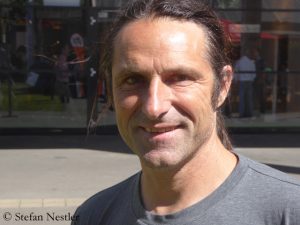

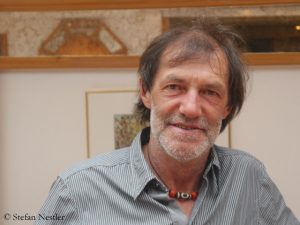
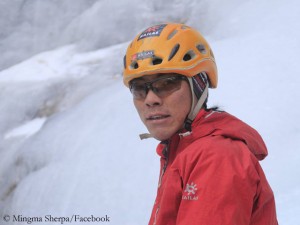
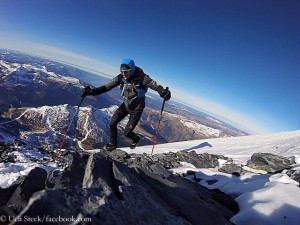
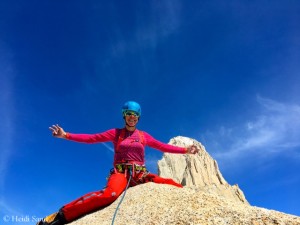

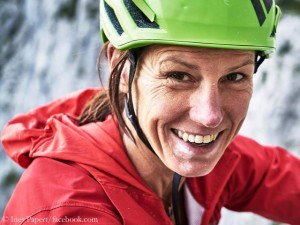
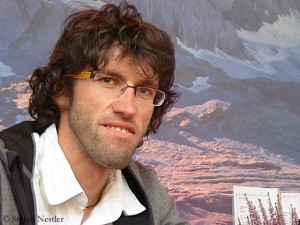
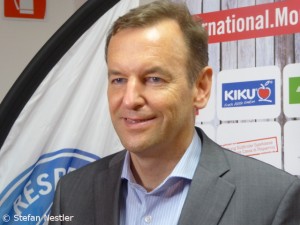
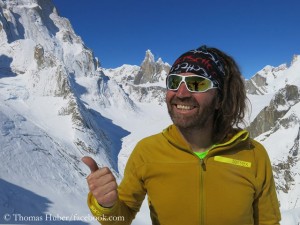
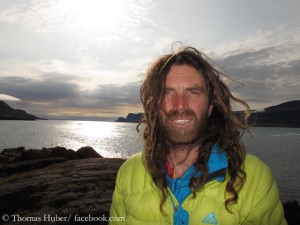
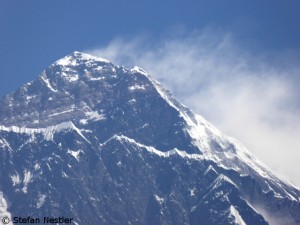
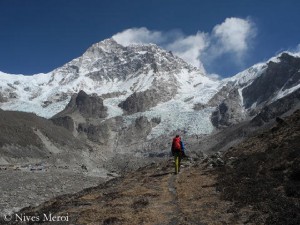
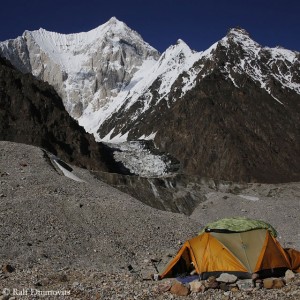
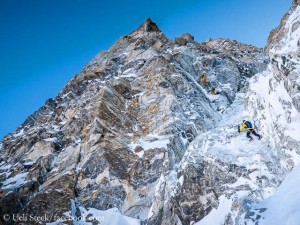





Feedback